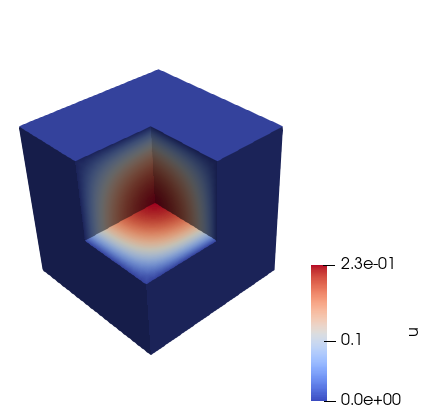Project: Discontinuous Galerkin Infrastructure For the finite element toolbox Ferrite.jl
Student: Abdulaziz Hamid
Mentor: Dennis Ogiermann & Fredrik Ekre
Organization: The Julia Language
Description: This project implements the infrastructure required to use discountinuous Galerkin method in the finite element toolbox Ferrite.jl.
| # | Title | State |
|---|---|---|
| 729 | ConstraintHandler for discontinuous interpolations | merged |
| 710 | Cross-elements coupling for DiscontinuousLagrange sparsity patterns. | merged |
| 747 | InterfaceCache & InterfaceIterator | merged |
| 751 | Make benchmarks work with master branch | merged |
| 743 | InterfaceValues for DG interface integration | merged |
| 779 | Implement FaceQuadratureRule for RefPrism and RefPyramid | merged |
| 790 | Arbitrary order Lagrange interpolations for hypercubes (with arbitrary basis) and triangle (equidistant basis only) | pending |
| 787 | DG heat equation tutorial | pending |
Ferrite uses ConstraintHandler to strongly enforce Dirichlet, affine and periodic dirichlet boundary conditions. Dirichlet boundary condition sets the nodal values at the specified nodes. This can be enforced strongly by modifying the stiffness matrix or weakly by using penalty terms.
ConstraintHandler didn't have proper support for DiscontinuousLagrange interpolations as the facedof_indices,edgedof_indices and vertexdof_indices aren't dispatched for discontinuous interpolation as all the degrees of freedom (dof) are moved to the cell interior.
The solution was creating new methods dirichlet_*dof_indices which default to *dof_indices for continuous interpolation and using it instead in ConstraintHandler.
PR #729: ConstraintHandler for discontinuous interpolations (merged)
create_sparsity_pattern creates a SparseMatrixCSC with stored values according to the dof numbering provided. This takes into account the coupling between fields inside the element but not cross-element coupling. However, when using DG methods the interface integrals result in cross-element coupling.
This was solved by modifying the functions to accept optional topology and cross_coupling arguments to add the cross-element coupling entries to the sparse matrix.
PR #710: Cross-elements coupling for DiscontinuousLagrange sparsity patterns. (merged)
Ferrite provides CellIterator and CellCache which are used to conveniently iterate over all, or a subset, of the cells in a grid. However, iterating over interfaces had to be done using two cell iterators and a neighborhood check, which isn't convinient nor effecient.
This was solved by introducting InterfaceIterator which iterates over all the interfaces of the grid effeciently by utilizing the topology.
PR #747: InterfaceCache & InterfaceIterator (merged)
Ferrite has benchmarking scripts to analyze its performance and help tracking down performance regression issues. These benchmarks were developed for continuous interpolations so adding support for DG methods require adding their benchmarks. However, these scripts were not updated to work with the master branch.
The scripts were updated to work with master branch in PR #751: Make benchmarks work with master branch (merged)
The benchmarks for discontinuous interpolations were added in PR #743: InterfaceValues for DG interface integration (pending)
Ferrite chaches shape function values and gradients at the quadrature points to optimize assembly performance using FEValues structs. Doing interface integrals involves using values from two different cells and has methods such as jumps and averages which are not present in FaceValues. Thus, implementing InterfaceValues was needed.
Also, when doing interface integrals the quadrature points must be synced to the same spatial coordinates on both sides of the interface, which is not the case by defauls. Thus, reinitializing InterfaceValues should transform the quadrature points from one side of the interface to another either using permutations or a transformation matrix. Using permutations should have better performance but only the hypercubes quadrature points are guaranteed to have a predetermined permutation, as simplices use tables not quadrature point generators.
Quadrature points transformations were implemented in PR #779: Implement FaceQuadratureRule for RefPrism and RefPyramid (merged)
InterfaceValues was implemented with quadrature points transformations in PR #743: InterfaceValues for DG interface integration (pending)
Part of the project was adding an example of using the interior penalty method in the heat equation example. The reason for choosing this example is its simplicity, as it's considered the hello-world of FEM.
The weak form solved in the example is
where
The example is in PR #787: DG heat equation tutorial (pending)
Another part of the project is utilizing sum-factorization to optimize assembly for higher order elements. This requires implementing arbitrary order interpolation as a first step.
Arbitrary order Lagrange and discontinuous Lagrange interpolations were implemented in PR #790: Arbitrary order Lagrange interpolations for hypercubes (with arbitrary basis) and triangle (equidistant basis only) (pending)
Most of the DG related methods utilize topology. Thus, optimizing topology construction can affect the performance of the overall routine.
PR #759: FaceSkeleton Vroom 1 (pending) speeds up the construction of FaceSkeleton by utilizing neighborhood information.
- Implement sum factorization for higher order integration as in Issue #389
I gratefully acknowledge the guidance of my mentors Fredrik Ekre and Dennis Ogiermann, and Ferrite members for always helping me throughout the project. Thanks ❤️
Ferrite source code: https://github.com/Ferrite-FEM/Ferrite.jl
